Discover the exciting world of soilless gardening with my step by step guide that will help you create a thriving garden without traditional soil. Whether you’re a beginner or a seasoned gardener, soilless gardening offers a range of benefits and opens up a world of possibilities for plant cultivation.
Starting seeds indoors is a fantastic way to kickstart your garden and extend the growing season. With better control and experimentation, you can ensure healthy seedlings that are ready to transplant when the time is right. Using a soilless mix or seed starting mix, which is lightweight and sterile, provides the ideal growing medium for your seeds.
Key Takeaways:
- Starting seeds indoors allows for better control and experimentation.
- Use a soilless mix or seed starting mix for optimal seedling growth.
- Consider aquaponics, a soilless gardening method that combines aquaculture and hydroponics.
- Choose from different types of aquaponic systems based on your needs and space availability.
- Essential components for an aquaponics system include a fish tank, grow bed, water pump, and more.
Starting Seeds Indoors: Kickstart Your Garden
Starting seeds indoors is a fantastic way to get a head start on your gardening journey, and with soilless mixes, you can ensure optimal conditions for seed germination. It’s important to start seeds about eight weeks before the risk of frost has passed in your area, giving your plants ample time to grow strong before the growing season begins. By starting indoors, you also have better control over the environment, allowing you to experiment with different seed varieties and growing techniques.
To kickstart your indoor gardening adventure, you’ll need a soilless mix or seed starting mix. These mixes are lightweight and sterile, providing an ideal medium for seed germination. Before planting, pre-moisten the soilless mix to ensure proper hydration. Fill seed trays or pots with the mix, following the instructions on the seed packet for planting depth. Lightly tamp the soil and water until the container feels significantly heavier. This helps create a moist, but not waterlogged, environment for your seeds to thrive.
During the germination process, it’s essential to keep the soil slightly moist, but not soaked. To prevent the risk of damping off, cover the trays with a transparent lid or plastic wrap until the first seedlings emerge. Once the seedlings have sprouted, remove the cover to promote air circulation and prevent excessive moisture buildup. You can also use small fans to gently circulate air around the trays, which helps strengthen the seedlings and reduce the risk of fungal diseases.
Remember to water your seedlings only when the surface of the soil has dried slightly. This encourages healthy root growth and helps prevent overwatering, which can lead to root rot. With proper care and attention, your indoor seedlings will grow into strong, healthy plants ready to be transplanted into your garden once the weather permits. So, why wait? Start your seeds indoors and watch your garden flourish!
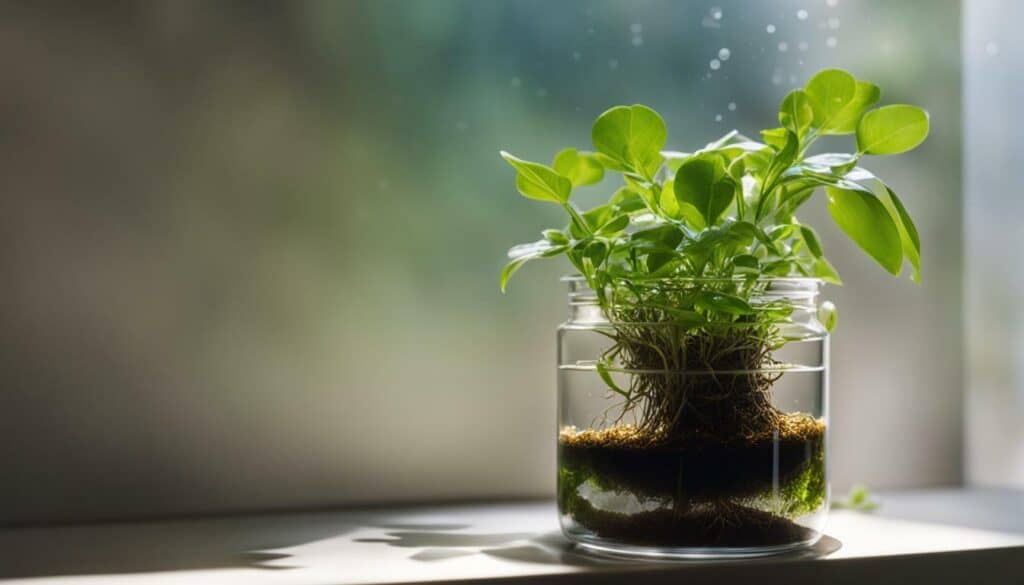
Summary:
- Starting seeds indoors allows for better control and experimentation.
- Use soilless mixes or seed starting mixes for optimal seed germination.
- Keep the soil slightly moist and provide adequate air circulation for healthy seedling growth.
- Transplant your indoor seedlings into your garden once the weather allows.
Hydroponic Gardening Techniques: Growing Without Soil
Hydroponic gardening offers a soilless solution for growing plants, providing precise control over nutrient levels and water delivery. By harnessing the power of nutrient-rich water, hydroponics allows plants to thrive in a controlled environment, resulting in faster growth and higher yields. This technique is particularly beneficial for indoor gardening, where space and soil quality may be limited.
One popular hydroponic technique is the nutrient film technique (NFT), where a shallow, constantly flowing film of nutrient-rich water is circulated over the roots of the plants. This method ensures that plants receive a continuous supply of water and nutrients, promoting optimal growth. Another technique is the deep water culture (DWC) system, where plant roots are suspended in a nutrient solution with an oxygenated air stone. This system allows for maximum oxygen absorption and encourages vigorous root development.
Hydroponics also offers the opportunity to experiment with vertical gardening, utilizing space more efficiently. Vertical hydroponic systems, such as the tower garden, allow you to grow a wide variety of plants in a compact vertical space, making it ideal for urban gardens or limited backyard areas.
A Hydroponic Adventure: A Personal Story
“When I first embarked on my hydroponic gardening journey, I was amazed by the results. My plants grew faster and stronger than ever before, all without the need for soil. With hydroponics, I could tailor the nutrient levels to suit each plant’s specific needs, ensuring they received the perfect balance of minerals and vitamins. Not to mention the convenience of having a compact, indoor garden that required less maintenance and water compared to traditional gardening methods. It truly revolutionized my approach to gardening and opened up a whole new world of possibilities.”
Whether you’re a seasoned gardener looking to expand your skills or a beginner eager to embrace the world of soilless gardening, hydroponics offers an exciting and innovative alternative. With the right techniques and equipment, you can embark on a hydroponic adventure, growing vibrant plants and reaping the benefits of this sustainable and efficient gardening method.
| Benefits of Hydroponic Gardening | Advantages |
|---|---|
| Precise control over nutrient levels | Allows for optimized plant growth and health |
| Water conservation | Hydroponics uses up to 90% less water compared to traditional soil gardening |
| Year-round gardening | Indoor hydroponic systems provide the opportunity to grow plants regardless of the season |
| High yields | Plants grown hydroponically often produce larger harvests |
| Saves space | Vertical hydroponic systems maximize growing area |
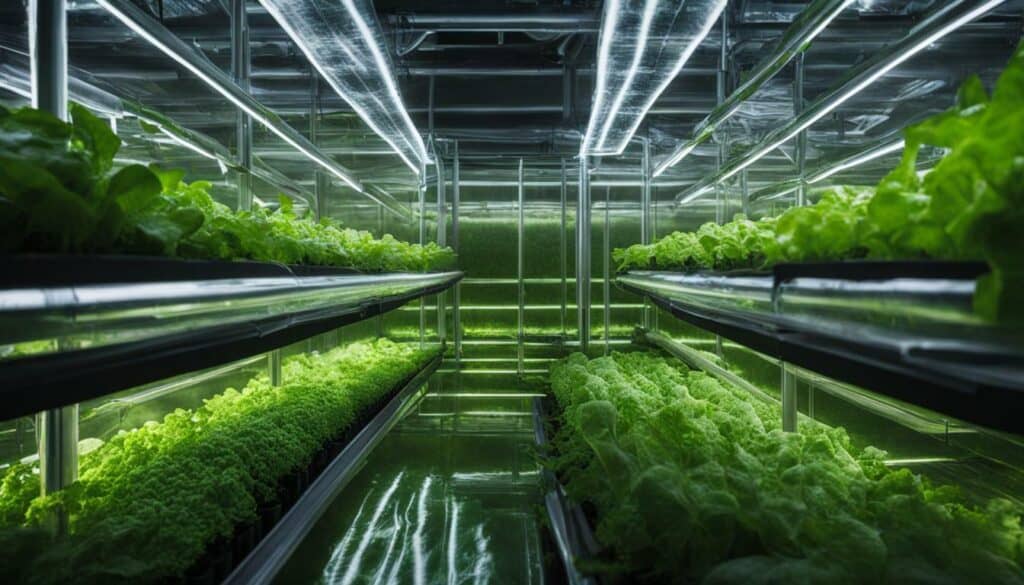
So, why not embrace the world of hydroponic gardening and experience the joy of growing plants without soil? Whether you’re interested in starting small with a countertop system or want to create a full-scale hydroponic garden, the possibilities are endless. With a little knowledge and creativity, you can cultivate a thriving soilless garden that will amaze and inspire you.
Aquaponics: The Perfect Symbiotic System
Experience the ultimate closed-loop system of aquaponics, where fish and plants work together to create a sustainable and thriving garden. Aquaponics is a soilless gardening method that combines aquaculture and hydroponics, creating a symbiotic relationship between aquatic life and plant growth. This innovative approach offers numerous benefits, including sustainability, high yields, and water conservation.
Aquaponics operates on the principle that fish waste contains valuable nutrients that can be utilized by plants. In an aquaponic system, fish are kept in a tank where their waste serves as a natural fertilizer for the plants. The plants, in turn, filter the water, providing a clean environment for the fish. This closed-loop system minimizes waste, reduces the need for chemical fertilizers, and promotes ecological balance.
To start an aquaponics system, it is essential to consider factors such as personal preferences, environmental considerations, and available space. There are different types of aquaponic systems to choose from, including media-based, raft, nutrient film technique (NFT), and hybrid systems. Each system has its own advantages and suitability for specific plants and environments.
Types of Aquaponic Systems
1. Media-based: In this system, plants grow in a medium such as expanded clay pebbles or gravel. The medium supports the plants, provides a habitat for beneficial bacteria, and aids in the filtration process.
2. Raft: Also known as deep water culture (DWC), this system involves floating the plants on rafts in a nutrient-rich water solution. The plants’ roots are submerged in the water, allowing for efficient nutrient uptake.
3. Nutrient Film Technique (NFT): This system employs a continuous flow of nutrient-rich water that flows over the roots of the plants, allowing them to extract the necessary nutrients. The excess water is then recirculated back to the fish tank.
4. Hybrid: A hybrid system combines the benefits of multiple aquaponic techniques. It can be a combination of media-based, raft, or NFT systems, tailored to suit specific requirements.
Regardless of the system chosen, essential components of an aquaponics system include a fish tank, grow bed, water pump, air pump, tubing and fittings, and plumbing. These components work together to create an optimized environment for both fish and plants, ensuring their mutual growth and success.
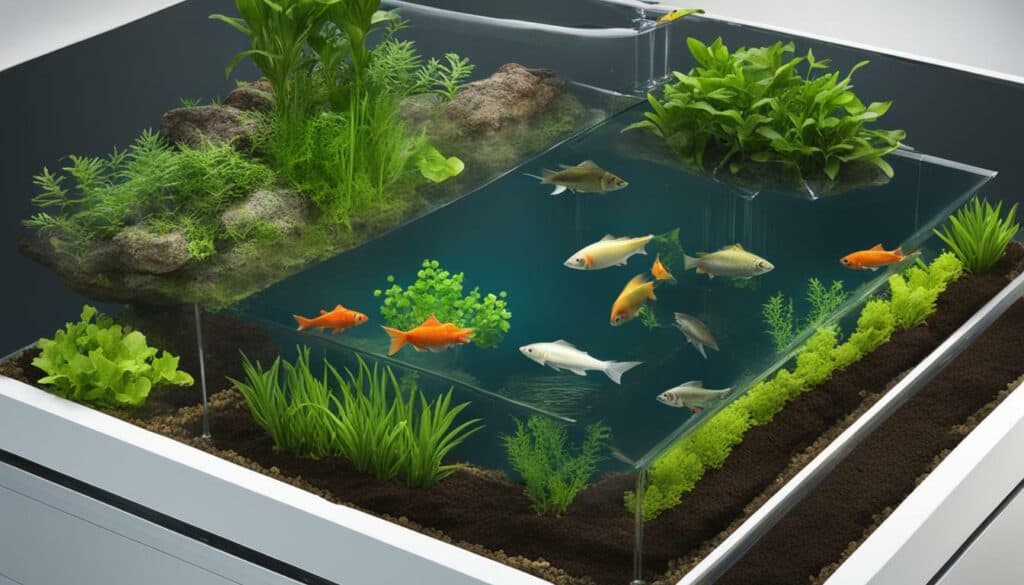
Summary:
Aquaponics revolutionizes gardening by providing a sustainable and symbiotic system where fish and plants thrive together. By utilizing fish waste as a natural fertilizer, aquaponics minimizes waste, promotes ecological balance, and reduces the need for chemical fertilizers. Different types of aquaponic systems, such as media-based, raft, nutrient film technique (NFT), and hybrid systems, offer flexibility and suitability for various plant types and environments. Essential components, including a fish tank, grow bed, water pump, air pump, tubing, and plumbing, form the foundation of a successful aquaponics setup. Embrace aquaponics and experience the benefits of this innovative soilless gardening method.
References:
- Smith, S.E. (2007, September 21). What Is Aquaponics? Retrieved from https://www.wisegeek.com/what-is-aquaponics.htm
- Sumner, M. E. (2010). Handbook of soil science. CRC Press.
- Rakocy, J. E., Bailey, D. S., Shultz, R. C., & Thoman, E. S. (2004). Aquaponic production of tilapia and basil: comparing a batch and staggered cropping system. Aquaculture Research, 35(7), 575-581.
| Type of Aquaponic System | Advantages |
|---|---|
| Media-based | Provides physical support to plants, aids in filtration, and creates a habitat for beneficial bacteria. |
| Raft (Deep Water Culture) | Efficient nutrient uptake by plants, allows plants to float in nutrient-rich water. |
| Nutrient Film Technique (NFT) | Continuous flow of nutrient-rich water optimizes nutrient uptake by plants. |
| Hybrid | Offers flexibility by combining the benefits of multiple aquaponic systems. |
Choosing the Right Aquaponic System: Customize to Your Needs
When it comes to aquaponics, there are various system options available, allowing you to customize your setup based on space availability and personal preferences. The type of system you choose will determine the size and complexity of your aquaponics operation. Let’s explore the different types of aquaponic systems to help you make an informed decision.
1. Media-Based System: This type of aquaponic system uses a grow bed filled with a media such as gravel, clay pebbles, or coconut coir. The media provides support for the plants and acts as a biofilter, helping to convert fish waste into plant nutrients. It is a versatile system that can accommodate a wide variety of plant species.
2. Raft System: In a raft system, also known as a deep water culture (DWC) system, plants float on a raft made of a buoyant material such as foam boards, with their roots submerged in water. The nutrient-rich water is continuously circulated, providing a constant supply of nutrients to the plants. This system is ideal for growing leafy greens and herbs.
3. Nutrient Film Technique (NFT) System: The NFT system is a hydroponic method that is adapted for aquaponics. A thin film of nutrient-rich water flows over the bare roots of the plants, allowing them to absorb the necessary nutrients. This system is best suited for growing small, fast-growing plants such as lettuce and strawberries.
| System Type | Advantages | Disadvantages |
|---|---|---|
| Media-Based | Flexible for growing various plant species | Requires regular media maintenance |
| Raft | Good for leafy greens and herbs | Not suitable for larger plants or fruiting crops |
| NFT | Ideal for small, fast-growing plants | Highly dependent on constant water flow |
Before making a decision, consider factors such as available space, desired crop types, and the level of maintenance you are willing to commit to. Each system has its own unique advantages and challenges, so it’s important to choose the one that aligns with your goals and resources.
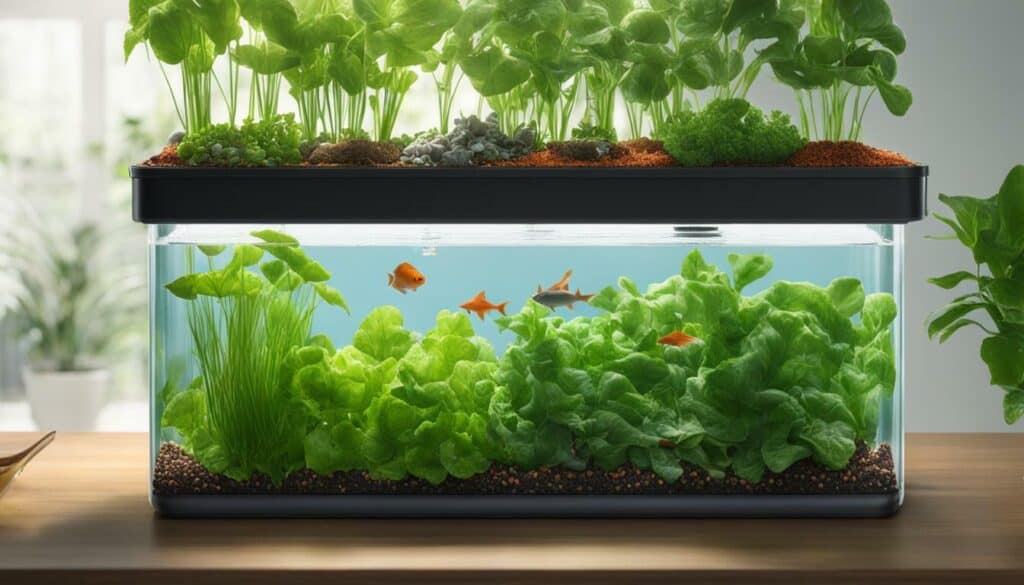
By selecting the right aquaponic system, you can create a self-sustaining ecosystem that produces fresh, organic food year-round. Start small and expand your system as you gain experience and confidence. With the freedom to customize your aquaponic setup, you can enjoy the benefits of soilless gardening and cultivate your own green thumb.
Essential Components for Your Aquaponics System
To create an efficient and thriving aquaponics system, you’ll need specific components that work together to provide ideal conditions for both fish and plants. These components include:
- A Fish Tank: The fish tank is the heart of your aquaponics system, providing a home for the fish. Choose a tank that is appropriate for the size and species of fish you plan to raise.
- A Grow Bed: The grow bed is where the plants are grown. It should be filled with a growing medium such as expanded clay pellets or gravel, which provide support for the plants and allow their roots to access the water and nutrients.
- A Water Pump: The water pump is responsible for circulating the water between the fish tank and the grow bed. It ensures that the fish waste is distributed to the plants, and the filtered water is returned to the fish tank.
- An Air Pump: The air pump provides aeration to the fish tank and the grow bed. It helps maintain optimal oxygen levels for the fish and promotes healthy root development in the plants.
- Tubing and Fittings: Tubing and fittings are used to connect the various components of the system. They allow water to flow smoothly and prevent leaks.
- Plumbing: Plumbing is essential for regulating the flow of water and controlling the system. It includes valves, pipes, and other fixtures that help maintain a balanced and stable environment.
By ensuring that these essential components are in place, you can create a well-functioning aquaponics system that supports the growth of both fish and plants. Remember to monitor water quality, temperature, and pH levels regularly to ensure optimal conditions for your aquaponics system.
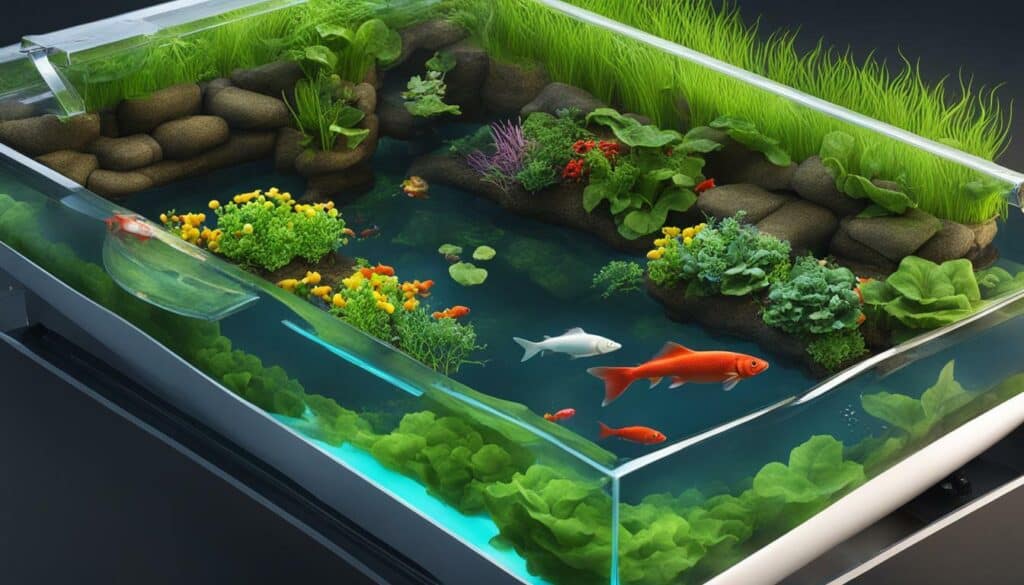
I hope this guide has provided you with valuable insights into the essential components required for a successful aquaponics system. By embracing soilless gardening techniques such as aquaponics, you can not only grow plants without soil but also create a sustainable and symbiotic environment where fish and plants thrive together. So, take the plunge and cultivate your green thumb with this innovative and exciting gardening method!
Benefits of Soilless Gardening: Flourish With Innovation
By embracing soilless gardening techniques, you open the door to a world of innovative growth, increased yields, and environmentally-friendly practices. Soilless gardening, such as starting seeds indoors and utilizing aquaponics, offers numerous benefits that are revolutionizing the way we garden.
Starting seeds indoors is a game-changer for gardeners. It allows for greater control over the growing environment, ensuring optimal conditions for seed germination and early growth. Using a soilless mix or seed starting mix provides a lightweight and sterile medium that promotes healthy root development. It also reduces the risk of diseases and pests that are commonly found in traditional soil. With soilless gardening, you can start your garden earlier in the season, extend the growing season, and experiment with a wider variety of plants.
Aquaponics, on the other hand, combines aquaculture and hydroponics to create a sustainable and productive gardening system. In an aquaponics setup, fish waste is converted into nutrients for plants, while the plants filter the water for the fish. This closed-loop system not only reduces waste but also conserves water by recycling it within the system. Aquaponics allows for year-round gardening, as it can be done indoors or in controlled environments. It offers high yields of fresh, nutrient-rich produce, making it an ideal choice for urban gardening and food production.
When considering soilless gardening, it’s important to choose the right system based on your needs and space availability. Different types of aquaponic systems, such as media-based, raft, nutrient film technique (NFT), and hybrid systems, offer various advantages and suit different gardening preferences. Additionally, essential components like fish tanks, grow beds, water pumps, and air pumps are crucial for a successful aquaponics system.
Benefits of Soilless Gardening:
- Sustainability: Soilless gardening techniques promote eco-friendly practices by reducing the reliance on traditional soil, conserving water, and minimizing chemical usage.
- High Yields: With better control over the growing environment, soilless gardening often results in higher yields of healthy and vibrant plants.
- Water Conservation: Aquaponics, in particular, uses a fraction of the water compared to traditional gardening methods, making it a sustainable choice for water-conscious individuals.
By embracing soilless gardening, you can unlock the potential for innovative growth and experience the rewards of gardening without the constraints of traditional soil. So why wait? Cultivate your green thumb today and embrace the benefits of soilless gardening.
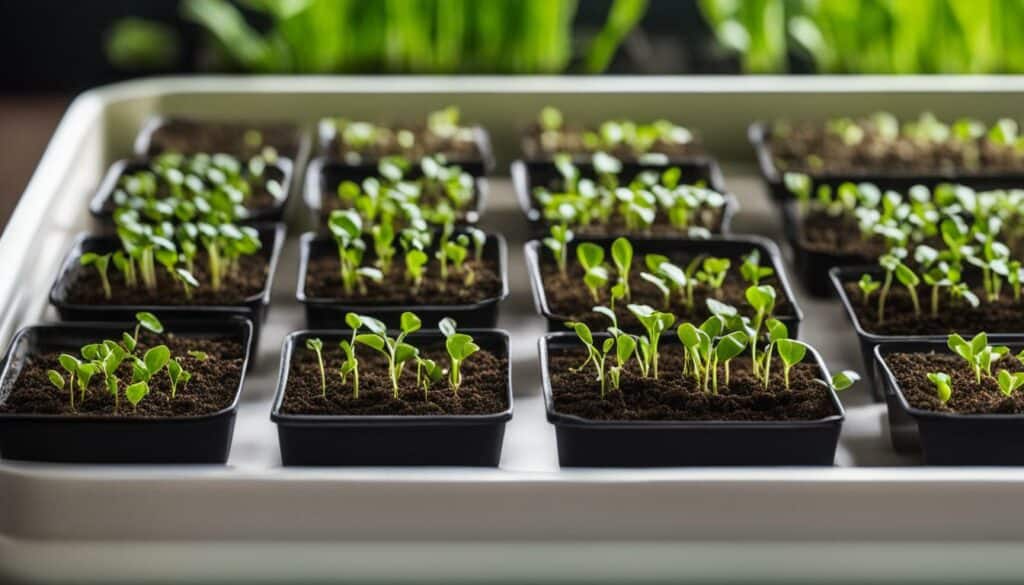
Tips and Tricks for Successful Soilless Gardening
Here are some expert tips and tricks to help you achieve fruitful results with your soilless gardening journey:
- Choose the right medium: When starting seeds indoors or setting up an aquaponics system, selecting the appropriate growing medium is crucial. Opt for a soilless mix or seed starting mix that is lightweight, sterile, and well-draining. This will provide the ideal environment for healthy root development.
- Monitor moisture levels: It’s important to strike a balance when it comes to watering your soilless garden. Overwatering can lead to root rot, while underwatering can result in stunted growth. Regularly check the moisture levels of the medium and adjust watering accordingly. Remember, it’s better to slightly underwater than overwater.
- Provide adequate light: Whether you’re growing seeds indoors or maintaining an aquaponics system, plants need sufficient light to thrive. Position your seed trays or hydroponic setup near a south-facing window or invest in grow lights to ensure your plants receive the required amount of light for optimal growth.
- Feeding and fertilizing: Soilless gardening relies on nutrient-rich solutions to nourish your plants. For hydroponics and aquaponics, use specialized fertilizers or fish waste to provide essential nutrients. When starting seeds indoors, begin feeding with a diluted liquid fertilizer once the seedlings have developed their first true leaves.
- Pest control: Although soilless gardening can reduce the risk of soil-borne pests, it’s still important to remain vigilant. Regularly inspect your plants for signs of pests and implement organic pest control methods as necessary. Neem oil, insecticidal soap, and companion planting with pest-repellent herbs can help keep unwanted visitors at bay.
Expert Quote:
“Soilless gardening allows for greater control over plant growth, leading to healthier plants and higher yields. Remember to pay attention to the specific needs of your chosen method, such as light, water, and nutrient requirements, and don’t be afraid to experiment and learn from each gardening season.” – Emily Green, Horticulture Specialist
By following these tips and tricks, you can enjoy a successful soilless gardening experience. Embrace the innovative techniques of seed starting indoors and aquaponics, and watch your plants flourish without traditional soil.
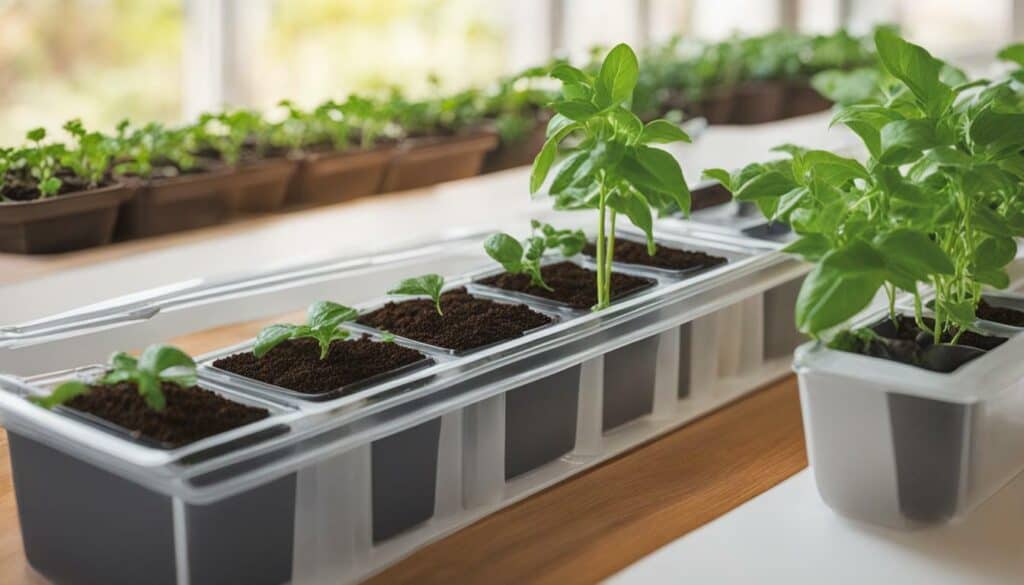
Conclusion: Cultivate Your Green Thumb Today
With my step by step guide and a mindset open to innovation, you can cultivate a thriving garden using soilless gardening techniques and embrace the joy of green thumb success.
Starting seeds indoors is an excellent way to kickstart your gardening journey. By using a soilless mix or seed starting mix, you can have better control and experimentation while ensuring the well-being of your plants. Pre-moisten the lightweight and sterile mix, then add it to seed trays according to the planting depth instructions on the seed packet. Keep the trays covered until the seedlings emerge, then remove the cover and maintain air circulation with small fans. Remember to water only when the soil surface has slightly dried to encourage healthy root growth.
Another fascinating soilless gardening method is aquaponics. By combining aquaculture and hydroponics, aquaponics provides a sustainable and high-yield solution for growing fresh produce. This closed-loop system utilizes fish waste to feed the plants, while the plants filter the water for the fish. Not only does aquaponics offer the benefits of water conservation and reduced chemical usage, but it also allows for year-round gardening. Before starting an aquaponics system, consider factors such as personal preferences, environmental considerations, and available space. Choose from various types of aquaponic systems, including media-based, raft, nutrient film technique (NFT), and hybrid systems, to ensure the best fit for your needs.
Essential components for a successful aquaponics system include a fish tank, grow bed, water pump, air pump, tubing and fittings, and plumbing. By assembling these components and following the proper guidelines, you can create an efficient and flourishing aquaponic setup.
By embracing soilless gardening techniques like seed starting indoors and exploring the world of aquaponics, you can experience the joy of growing your own plants without traditional soil. The benefits of soilless gardening are numerous, including sustainability, high yields, fresh produce, water conservation, reduced chemical usage, and the ability to garden year-round. So, why not step into the world of soilless gardening and cultivate your green thumb today?
Can Beginners Start with Soilless Gardening Using the Easy-to-Follow Guide?
Can beginners start with soilless gardening using the easy-to-follow guide? Absolutely! With gardening tips for beginners, anyone can begin their soilless gardening journey. This comprehensive guide offers step-by-step instructions, highlighting the benefits of soilless gardening and providing essential tips for success. From choosing the right hydroponic system to understanding nutrient solutions, this guide makes soilless gardening accessible to all aspiring green thumbs.
FAQ
Q: Why is starting seeds indoors beneficial?
A: Starting seeds indoors allows for better control and experimentation, and it helps kickstart your garden before the risk of frost has passed.
Q: What type of mix should I use for starting seeds indoors?
A: It is recommended to use a soilless mix or seed starting mix, which is lightweight and sterile.
Q: How should I water my seed trays?
A: Pre-moisten the soilless mix and water until the container feels significantly heavier. Only water again when the surface of the soil has dried slightly.
Q: How can aquaponics benefit my gardening experience?
A: Aquaponics offers sustainability, high yields, fresh produce, water conservation, reduced chemical usage, and the ability to garden year-round.
Q: What factors should I consider before starting an aquaponics system?
A: Consider personal preferences, environmental considerations, and location and space availability before starting an aquaponics system.
Q: What are the different types of aquaponic systems I can choose from?
A: You can choose from media-based, raft, nutrient film technique (NFT), and hybrid systems based on your needs and space availability.
Q: What are the essential components of an aquaponics system?
A: The essential components include a fish tank, grow bed, water pump, air pump, tubing and fittings, and plumbing.
Q: What are the benefits of soilless gardening?
A: Soilless gardening offers sustainability, high yields, fresh produce, water conservation, reduced chemical usage, and the ability to garden year-round.
Q: Do you have any tips for successful soilless gardening?
A: Yes, some tips include maintaining proper moisture levels, providing adequate airflow, and monitoring the health of your plants and fish in an aquaponics system.

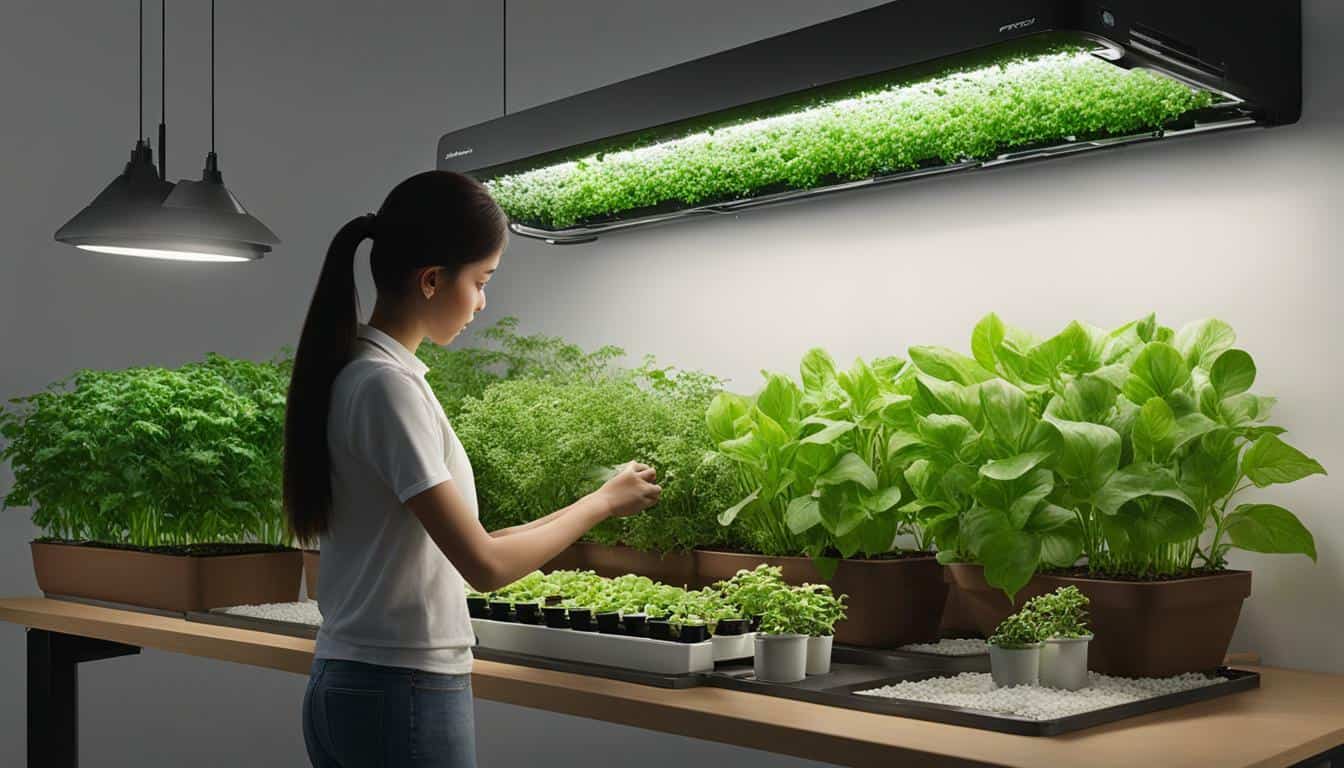



Leave a Reply